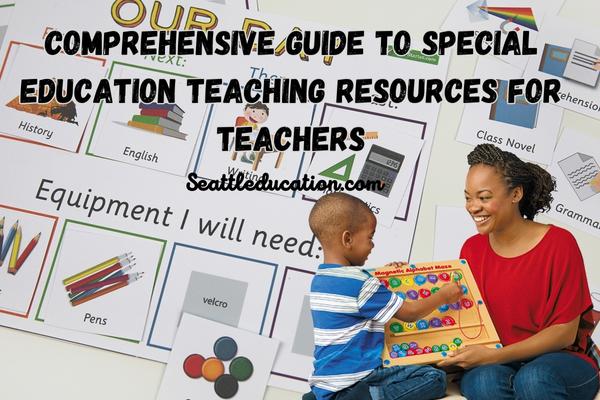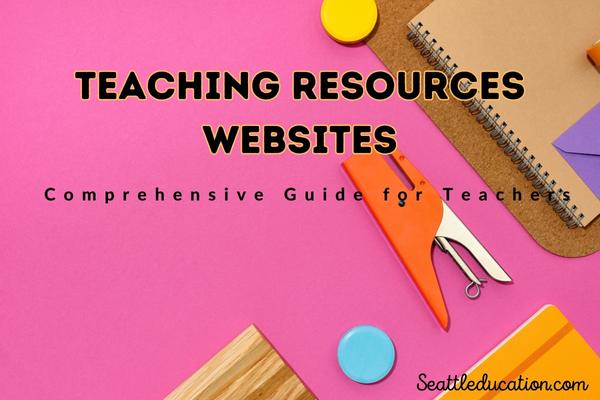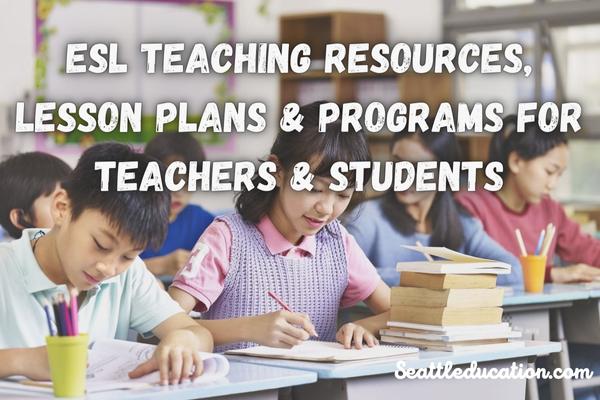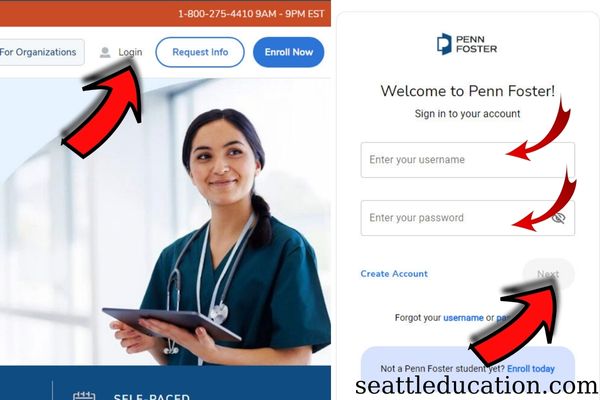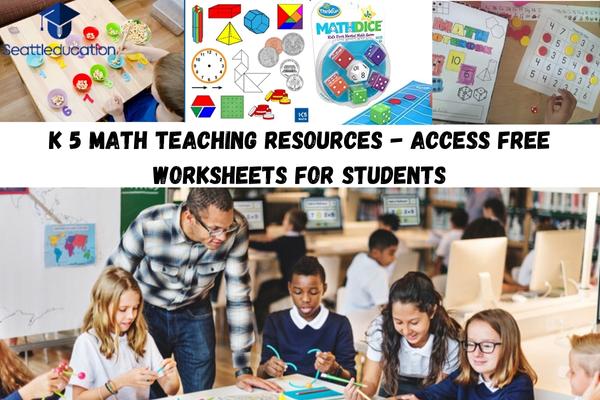Comprehensive Guide to Special Education Teaching Resources for Teachers
If you’re a special education teacher, you know how crucial it is to have access to high-caliber materials that will aid in your students’ academic development. In this blog on Seattleducation.com, we’ll look at 10 websites of Special Education Teaching Resources that can assist teachers of children with special needs organize their classrooms, modify their lessons to meet the requirements of their students, and adopt efficient pedagogical practices.
Introduction: Special Education & Needs Resources
Definition of Special Education & The Needs of Special Needs Students
Special education is the provision of educational aid and services to children with extraordinary needs. These pupils demand teaching methodologies and resources distinct from those typically utilized in a typical classroom.
A special education teacher has the expertise and experience to work with children who have specific needs, assess those requirements, and develop personalized education programs (IEPs) for such students.
The specialized educational resources offered to these students are vital to their learning and development. Visual aids, manipulatives, and technology are examples of interactive features that can be used to engage and facilitate the learning of children with specific needs. A huge collection of books and other resources can also assist teachers to better serve their students.
The IEP, or individual education plan, is vital to special education. This paper describes each student’s expected outcomes and outlines a method for achieving them. The Individualized Education Program (IEP) is established with input from parents, educators, and other professionals, and is regularly amended to reflect the student’s growth and changing needs.
Nonetheless, some children with particular requirements might function better in a setting with greater structure. A personalized school or classroom where each student may get the help they need is one possibility for this kind of training.
See the role of special education teachers here:
Importance of Special Education Resources
Here are some reasons why special education resources are important:
- Tailored instruction: Dedicated educational resources provide children with disabilities with personalized teaching that is targeted to their specific requirements. This method assures that these students receive an education tailored to their unique abilities, capabilities, and obstacles.
- Accommodations and modifications: Dedicated educational resources include accommodations and modifications that allow students with disabilities to access the curriculum and participate in classroom activities. These accommodations may include assistive technology, specialized assets, or modified assignments.
- Inclusion: Dedicated educational resources encourage inclusion by allowing students with disabilities to learn and interact with their peers in a supportive and inclusive atmosphere. Inclusion has been proved to help both children with disabilities and their typically developing peers in different ways.
- Individualized education plans (IEPs): They are often provided through personalized education plans (IEPs), which are developed collaboratively by educators, parents, and students. IEPs outline the student’s goals, accommodations, and modifications, as well as the services and supports they will receive.
- Improved outcomes: Dedicated educational resources can help students with disabilities achieve scholar and social success, which can lead to improved outcomes in adulthood, such as higher employment rates, greater independence, and improved quality of life.
Overall, special education resources are critical for ensuring that students with disabilities receive a quality education that meets their unique needs and supports their academic and social success.
Special Education Teaching Resources to Get You Started
Overview of Training & Professional Development Opportunities
Special education instructors have access to a variety of training and professional development options to expand their skills and expertise. These possibilities consist of:
- Workshops and Conferences
- Online Training
- Graduate Programs
- Professional Organizations (Council for Exceptional Children (CEC) and the National Association of Special Education Teachers (NASET))
- In-Service Training
Overall, there are several training and continuing professional options for special education instructors to increase their skills and expertise. These chances can support teachers in keeping abreast of the most recent research and best practices in the field, thereby improving the outcomes for their students.
List of Resources For Special Education Teachers Who Are Just Starting Out
These resources may prove helpful to first-year special education teachers:
- National Center for Learning Disabilities (NCLD): NCLD is a valuable resource for educators in the field of special education.
- Council for Exceptional Children (CEC): CEC is a professional association that provides special education instructors through webinars, books, and conferences.
- Special Education Guide: This website contains information regarding special education laws, teaching practices, and resources for students with various deformities.
- Teaching Students with Disabilities: This website provides techniques and materials for teaching kids with impairments.
- LD Online: LD Online provides information and tools, including instructional methods and assistive technology, for teaching students with learning difficulties.
- Autism Speaks: Autism Speaks provides information and resources for educating autistic students, such as instructional tactics and sensory aids.
- Intervention Central: Intervention Central offers teaching methods and resources to students with scholar and behavioral difficulties.
- National Autism Center: The National Autism Center provides evidence-based teaching materials for autistic pupils.
- Reading Rockets: Reading Rockets provides instructional ideas and materials for educating struggling readers.
- Understood: Understood has materials to help teachers teach students with deformities like ADHD, dyslexia, and autism.
These resources can help teachers of students with specific needs learn more about the different kinds of deformities they may encounter and the best ways to teach and help their students.
Online Resources For Lesson Planning, Assessments & More
There are a variety of online resources available for special education teachers to help with lesson planning, assessments, and more. Here are some websites you might find helpful:
- National Center for Learning Disabilities (NCLD): NCLD provides a range of resources for special education teachers, including learning objectives, activities, and continuing professional opportunities.
- Intervention Central: Free assessments and interventions.
- The National Association of Special Education Teachers (NASET): Learning objectives, worksheets, and continuing professional opportunities.
- Edmentum: Assessments, learning objectives, and activities.
- ReadWriteThink: ReadWriteThink provides a variety of learning objectives, activities, and resources for special education teachers focused on literacy and language development
- Special Education Guide: learning objectives, assessments, and continuing professional opportunities.
- Autism Speaks: It provides resources and support for teachers of students with autism, including learning objectives, behavior management strategies, and assistive technology resources.
- The Council for Exceptional Children (CEC): Learning objectives, continuing professional opportunities, and research-based practices.
- TeachThought: Learning objectives, activities, and methods for working with students with deformities.
- Understood: Learning objectives, activities, and tools for working with students with learning and attention issues.
Get Help Teaching Special Needs Students
Tips For Working With Special Needs Students
- Build strong relationships: Build positive relationships with your students based on trust, mutual respect, and understanding. Take the time to get to know each student and their unique needs and abilities.
- Use personalized instruction: Tailor instruction to each student’s individual needs and abilities. Use a variety of teaching methods and materials to accommodate different learning styles and strengths.
- Incorporate technology: Use technology to enhance learning and engagement. There are a variety of assistive technology devices and software available that can help learners with specific needs access and participate in the curriculum.
- Create a positive learning environment: Create a supportive and inclusive learning environment where all students feel valued and respected. Incorporate positive behavior supports and social-emotional learning methods to help learners develop self-regulation skills.
- Communicate effectively: Communicate regularly with parents and other educators to ensure consistency and collaboration in supporting each student’s needs. Use clear, concise language and provide frequent feedback to students on their progress.
- Advocate for your students: Advocate for your students’ needs and rights both in and outside of the classroom. Stay up-to-date on current laws and policies related to special education and be prepared to advocate for changes that benefit your students.
- Be patient and flexible: Be patient and flexible when working with specific needs students. Remember that progress may be slow and that each student has unique needs and abilities. Be prepared to adapt your instruction and approach as needed to support each student’s success.
Maybe you’ll like:
How to Create IEPs For Students With Special Needs
Individualized Education Plans (IEPs) are written plans that outline a student’s unique learning needs, goals, and accommodations for success. They are typically created for students with specific needs, including those with deformities or who require additional support to access their education. Here are the steps for creating IEPs for students with specific needs:
- Assessment and Evaluation: Assessing the student’s learning requirements and present abilities is the first stage in the IEP development process. These may involve tests, behavioral assessments, and evaluations conducted by therapists and other specialists.
- Identify Goals and Objectives: Based on the assessment results, the IEP team (which includes teachers, parents, and specialists) will identify specific goals and objectives for the student to achieve. These goals should be measurable, specific, and relevant to the student’s needs.
- Develop Accommodations and Modifications: Accommodations and modifications are changes to the learning environment or curriculum that help the student access their education. These can include things like extended time on tests, preferential seating, or modified assignments.
- Write the IEP: Once the goals, objectives, accommodations, and modifications have been identified, the IEP team will write the actual plan. This should include a detailed description of the student’s strengths and challenges, as well as specific methods for achieving the identified goals.
- Review and Revise: IEPs are living documents that should be reviewed and revised on a regular basis. The team should meet at least once a year to review the student’s progress and make any necessary adjustments to the plan.
Creating an effective IEP requires collaboration among teachers, parents, and specialists to ensure that the student’s unique needs are met. By following these steps, the IEP team can create a plan that supports the student’s scholar and personal success.
Special Education Resources By Topic
Overview of Resources Available For Each Topic
Here is an overview of dedicated educational resources available for each topic:
- Reading: Special education teachers can support students with deformities by utilizing a variety of reading resources, including leveled readers, audiobooks, and digital texts with built-in features such as text-to-speech and highlighting. In addition, teachers can employ phonics-based programs, graphic organizers, and graphic supports to support kids develop their reading skills.
- Writing: To support children with impairments in writing, teachers can use resources such as visual organizers, writing prompts, and assistive technology solutions like speech-to-text software. In addition, they can provide customized feedback and permit students to work at their own pace.
- Math: Mathematical ideas can be difficult for kids with specific needs to grasp, but teachers can help by using tools that employ multimodal teaching strategies. Assistive technologies such as calculators and mathematics programs with in-built assistance are also available to them.
- Science: To support students with deformities in science, teachers can use hands-on learning experiences, graphic supports, and simplified language to help learners understand scientific concepts. They can also use assistive technology tools like text-to-speech software to help learners access science texts.
- Social studies: Special education teachers can use resources like videos, graphic organizers, and adapted texts to help learners with deformities understand social studies concepts. They can also provide opportunities for hands-on learning experiences and use digital resources to enhance their teaching.
- Social-emotional learning: To support the social-emotional development of students with deformities, teachers can use resources like social stories, graphic supports, and mindfulness activities. They can also provide opportunities for social interaction and incorporate opportunities for self-reflection and self-regulation.
Tips for Incorporating Resources Into Lesson Planning & Instruction
Inclusion and support for all children can be fostered in the classroom through the use of dedicated educational resources. If you want to perform this successfully, consider the following advice:
If you have pupils who are disabled, you should familiarize yourself with their individual education programs (IEPs) and Section 504 plans. These plans outline the student’s strengths, areas of difficulty, and the precise accommodations and supports that will be put in place to support them do well in school. By doing so, you can better adapt your training materials and procedures to their individual needs.
Make use of a wide range of instructional materials and methods to reach students of varying backgrounds and aptitudes. Helpful tools for students with sensory, motor, or cognitive impairments include visual supports, graphic organizers, and assistive technology. Make use of varied teaching strategies to give students multiple entry points into the content.
Facilitate mutually beneficial relationships between students with and without deformities to foster a welcoming and accepting classroom setting. Inspire mutual aid and cooperation amongst classmates. To encourage the actions you want to see more of, try using positive reinforcement.
Collect some data and use it to inform your teaching. The quality of your teaching can be evaluated by gathering data on student development. Adapt your methods as needed to ensure that students with deformities are able to achieve their full scholar potential.
Share materials and strategies with colleagues working in special education and related fields. To better support kids with impairments, educators should regularly participate in professional development activities and read relevant scholar literature.
A more welcoming and helpful learning environment for all students is possible when teachers like you make use of special education teaching tools in their daily work.
Tips for Staying Up-to-Date on The Latest Research & Trends in Special Education
- Follow reputable sources: Track the leading special education journals, publications, and organizations. By subscribing to their emails and feeds, you will remain current with the most recent findings and trends. Such organizations include the Council for Exceptional Children, the Journal of Special Education, and the NASETs.
- Attend conferences and workshops: Engaging in professional development activities, such as conferences and workshops, can help you stay abreast of the most recent special education research and trends. Also, conferences are a terrific chance to network with other experts and exchange ideas.
- Connect with peers: Connect with other teachers, administrators, and professionals in special education to share resources, ideas, and research. Join special education-related online forums or social media groups to work with others and keep informed.
- Use technology: Use digital resources such as online databases, podcasts, and webinars to stay current on special education trends. Numerous organizations provide free online special education courses and webinars.
- Read research articles: Read new research articles on special education in order to stay abreast of the most recent results and best practices. These articles can be accessed through university resources, such as JSTOR or Google Scholar, or through the publications of your professional organization.
- Seek out professional development opportunities: Explore options for professional advancement, such as getting postgraduate degrees or special education certifications. These programs will give you the most up-to-date special education teaching information and abilities.
- Stay in touch with former students: Maintain contact with former students to determine how they are doing and which tactics were effective. You may learn about new strategies or tools that can help you keep up with the most recent special education research and trends.
Conclusion
In conclusion, dedicated educational resources are crucial for ensuring that students with deformities receive the education and support they need to succeed.
However, it’s important to recognize that there is still much work to be done in this area. Many schools and educators still lack the resources they need to effectively support students with deformities, and there are significant disparities in access to these resources across different regions and communities.
Follow our site, Seattleducation.com, for more related articles. Thanks for reading!

